Mucosal adjuvant activity of flagellin in aged mice
- PMID: 18367233
- PMCID: PMC2366812
- DOI: 10.1016/j.mad.2008.01.009
Mucosal adjuvant activity of flagellin in aged mice
Abstract
We evaluated the ability of flagellin, a highly effective mucosal adjuvant in mice and non-human primates, to promote mucosal innate and adaptive immunity in aged mice. We found that intratracheal instillation of flagellin induced a stronger respiratory innate response in aged mice than in young mice, and that intranasal instillation of flagellin was equally effective at triggering recruitment of T and B lymphocytes to the draining lymph nodes of young and aged mice. Intranasal immunization of aged mice with flagellin and the Yersinia pestis protein F1 promoted specific IgG and IgA production, but at lower levels and lower avidities than in young mice. Although intranasal instillation of flagellin and F1 antigen increased germinal center formation and size in young mice, it did not do so in aged mice. Our findings are consistent with the conclusion that flagellin can promote adaptive immune responses in aged mice, but at a less robust level than in young mice.
Figures
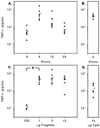
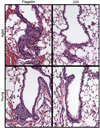



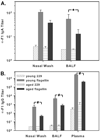
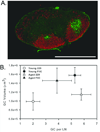
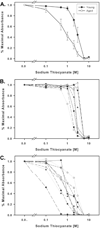
Similar articles
-
Flagellin is an effective adjuvant for immunization against lethal respiratory challenge with Yersinia pestis.Infect Immun. 2006 Feb;74(2):1113-20. doi: 10.1128/IAI.74.2.1113-1120.2006. Infect Immun. 2006. PMID: 16428759 Free PMC article.
-
Use of recombinant flagellin in oil-in-water emulsions enhances hemagglutinin-specific mucosal IgA production and IL-17 secreting T cells against H5N1 avian influenza virus infection.Vaccine. 2015 Aug 20;33(35):4321-9. doi: 10.1016/j.vaccine.2015.03.082. Epub 2015 Apr 6. Vaccine. 2015. PMID: 25858857
-
Mucosal immunization with purified flagellin from Salmonella induces systemic and mucosal immune responses in C3H/HeJ mice.Vaccine. 2004 Sep 9;22(27-28):3797-808. doi: 10.1016/j.vaccine.2003.12.035. Vaccine. 2004. PMID: 15315861
-
Antigen replacement of domains D2 and D3 in flagellin promotes mucosal IgA production and attenuates flagellin-induced inflammatory response after intranasal immunization.Hum Vaccin Immunother. 2013 May;9(5):1084-92. doi: 10.4161/hv.23809. Epub 2013 Feb 1. Hum Vaccin Immunother. 2013. PMID: 23377752 Free PMC article.
-
Flagellin as a vaccine adjuvant.Expert Rev Vaccines. 2018 Apr;17(4):335-349. doi: 10.1080/14760584.2018.1457443. Epub 2018 Mar 30. Expert Rev Vaccines. 2018. PMID: 29580106 Review.
Cited by
-
Immunosenescence and novel vaccination strategies for the elderly.Front Immunol. 2013 Jun 28;4:171. doi: 10.3389/fimmu.2013.00171. Print 2013. Front Immunol. 2013. PMID: 23825474 Free PMC article.
-
A fusion protein vaccine containing OprF epitope 8, OprI, and type A and B flagellins promotes enhanced clearance of nonmucoid Pseudomonas aeruginosa.Infect Immun. 2009 Jun;77(6):2356-66. doi: 10.1128/IAI.00054-09. Epub 2009 Apr 6. Infect Immun. 2009. PMID: 19349426 Free PMC article.
-
Comparative sequence analysis elucidates the evolutionary patterns of Yersinia pestis in New Mexico over thirty-two years.PeerJ. 2023 Sep 26;11:e16007. doi: 10.7717/peerj.16007. eCollection 2023. PeerJ. 2023. PMID: 37780382 Free PMC article.
-
A gold nanoparticle-linked glycoconjugate vaccine against Burkholderia mallei.Nanomedicine. 2015 Feb;11(2):447-56. doi: 10.1016/j.nano.2014.08.005. Epub 2014 Sep 3. Nanomedicine. 2015. PMID: 25194998 Free PMC article.
-
Recombinant rabies viruses expressing GM-CSF or flagellin are effective vaccines for both intramuscular and oral immunizations.PLoS One. 2013 May 20;8(5):e63384. doi: 10.1371/journal.pone.0063384. Print 2013. PLoS One. 2013. PMID: 23700422 Free PMC article.
References
-
- Agrawal A, Agrawal S, Cao JN, Su H, Osann K, Gupta S. Altered innate immune functioning of dendritic cells in elderly humans: a role of phosphoinositide 3-kinase-signaling pathway. J Immunol. 2007;178:6912–6922. - PubMed
-
- Alignani D, Maletto B, Liscovsky M, Ropolo A, Moron G, Pistoresi-Palencia MC. Orally administered OVA/CpG-ODN induces specific mucosal and systemic immune response in young and aged mice. J Leukoc Biol. 2005;77:898–905. - PubMed
-
- Anzelon AN, Wu H, Rickert RC. Pten inactivation alters peripheral B lymphocyte fate and reconstitutes CD19 function. Nat Immunol. 2003;4:287–294. - PubMed
-
- Aoshiba K, Nagai A. Chronic lung inflammation in aging mice. FEBS Lett. 2007;581:3512–3516. - PubMed
-
- Asanuma H, Hirokawa K, Uchiyama M, Suzuki Y, Aizawa C, Kurata T, Sata T, Tamura S. Immune responses and protection in different strains of aged mice immunized intranasally with an adjuvant-combined influenza vaccine. Vaccine. 2001;19:3981–3989. - PubMed
MeSH terms
Substances
Grants and funding
LinkOut - more resources
Full Text Sources
Other Literature Sources
Medical
Miscellaneous

